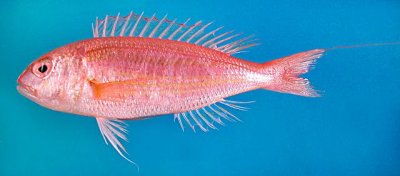
|
Misidentification
Meristic formula D, X + 9; A, III + 7; P, 15-17; V, I + 5; LL, 47-49
|
|
| photo: David Darom |
|
SHORT
DESCRIPTION
color : body pinkish, darker on the back becoming pinkish-silvery on the belly. Four pale yellow to golden –yellow stripes along the flank, the upper start at eye level and runs to caudal peduncle. The other three close to each other. Yellow spots on the cheek and the operculum.
common size : 5-20 cm (max. 30 cm). |
DISTINGUISHING CHARACTERISTICS
Dentex spp. – No filament in caudal fin. Apogon imberbis – Two dorsal fins. Anthias anthias and Callanthias ruber – Three flat spines on the upper posterior corner of the operculum. BIOLOGY / ECOLOGY
habitat : inhabits open sandy and muddy substrate at depths 20-200 m in its original area of distribution. In the Mediterranean it is caught mainly at 30-80 m. |
|
1st
MEDITERRANEAN RECORD
|

|
|
DISTRIBUTION
|
ESTABLISHMENT SUCCESS
|
|
|
MODE OF
INTRODUCTION |
IMPORTANCE TO
HUMANS |
KEY
REFERENCES
|
|
|
 Nemipterus japonicus
Nemipterus japonicus